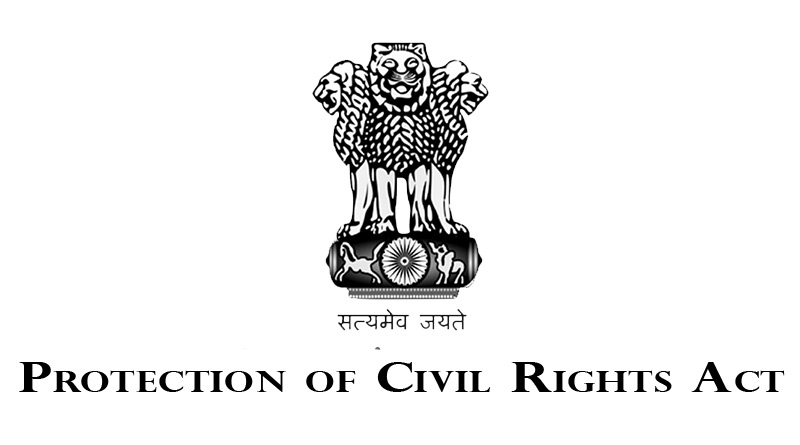Historical Background.
People of lower castes for centuries suffered social injustices by the higher castes. Under the traditional Hindu society, people belonging to Scheduled castes and Scheduled tribes communities were treated as the untouchables. They were prohibited from using public places and common provisions such as ponds, pools, parks, wells etc.
They were debarred from Hindu temples, places of worship and from using roads, vehicles, ferries, schools and public convenience. Their very shadows were considered as imminent pollutants and hence they were branded as untouchables.
These disabilities made life miserable for scheduled castes.
In order to tackle the problem of untouchability, Article 17 of the Constitution was incorporated in the Constitution to rescue the Scheduled Castes from the inhuman atrocities being committed against them by the upper castes society of the country. The untouchability has been abolished and any practice of it is an offence under Article 17 of Indian Constitution.
Article 35(a)(ii) provides that only the Parliament shall have the power to make law for prescribing punishment for those acts which are declared to be offences under Part-III. Thus only Parliament is empowered to make laws in respect of offence of untouchability as mentioned under Article17 which is to ensure uniformly throughout the country.
The Parliament passed the Untouchability (Offences) Act 1955, an improved version of the Untouchability Order,
1950, in order to give effect to provision under Article 17.
Object of the Untouchability (Offences) Act 1955.
- To give effect to the provision under Article 17 of Indian Constitution under which untouchability in any form has been abolished and any practice of it has been made an offence.
- To prescribe punishment for preaching and practice of Untouchability, for the enforcement of any disability arising therefrom and for matters connected therewith.
Constitutionality of State Legislations.
Even before the enactment of the Act, a number of states and Union territories had anti-disabilities laws in force between such as the Removal of Disabilities Act, Removal of Social Disabilities Act and Temple Entry Acts.
Many of these Acts were challenged as being unconstitutional on the ground of lack of legislative competency of the states in the light of Article 35 of the Constitution that empowered only the Parliament to enact laws in relation to Part III.
In State v. Kishan (AIR 1955 MP 207), the Indore Bench of the Madhya Pradesh High Court held that the powers of state legislatures to make laws prescribing punishment for those acts that were declared to be offences under
Article 17 were withdrawn by Article 35. Such power is now vested only in the Parliament. However the provision has a prospective application and it saved only laws in force in the State before the commencement of the Constitution, until they are altered, repealed or modified or amended by Parliament.
Similarly, state laws have been upheld in P.S Charya v. State of Madras (AIR 1956 Mad. 541) and State of U.P. v. Gulab Singh (AIR 1953 All.483).
Definition of Untouchability.
Neither Article 17 nor the Act defines the term "untouchability". However, broadly speaking, it refers to any social practice, which looks down on certain depressed classes, solely on account of their birth and disables them from having any interaction with people from the so called
higher castes or classes on equal footing.
The National Human Rights Commission (NHRC) in its Report on Prevention of Atrocities Against Scheduled Castes (Saxena Committee Report), has defined it as the practices evolved as social restrictions in sharing food, access to public places and denial of access to drinking water sources etc.
Recently, in the case of Indian Young Lawyers Association vs The State Of Kerala (2018 SCC OnLine SC 1690), the honourable apex court expounded the ambit of Article 17 and observed that "the social exclusion of women, based on menstrual status, is but a form of untouchability which is an anathema to constitutional values".
Punishments under the Act.
The Act:
provided punishment for enforcing certain religious, social and other kinds of disabilities on grounds of untouchability.
- provided penalties for the refusal of rendering services to Scheduled Castes and
- made provision for the use of public places by Scheduled Castes without any distinction of caste.
1976 Amendment
The 1976 Amendment was made due to following reasons:
The Act was not very effective in the eradication of untouchability and giving rise to dissatisfaction as the legislation failed to serve the purpose for which it was enacted.
The punishments awarded under the Act were inadequate.
Few cases had been filed under the Act.
The compoundable nature of the offences resulted in compromises and the punishments were small.
Mostly the victims were reluctant to lodge complaints for fear of social reprisal and harmful economic consequences at the hands of their landlords, money lenders and rural oligarchies who would not give them work or full wages for the work done by them.
The Government of India, therefore, appointed a committee in 1965 under the chairmanship of Shri Elayaperumal to study, inter alia problems of untouchability vis-à-vis the working of the Act and to suggest changes therein. The Committee found that:
when a Scheduled Caste wanted to quit the traditions of performing menial jobs, he was often confronted with social and economic boycott.
- the punishments imposed under the Act were too light and without any minimum requirements.
- instances where cases had been purposely delayed to cause hardship to complainants so that they would not have either the energy or the resources to pursue the case.
- the upper castes enjoyed the support of law enforcement officials like the police and magistrates, and that the Scheduled Castes would not get any protection from them.
- Apathetic attitude of magistrates who do not trust the evidence of Scheduled Castes on the ground that they are interested witnesses.
- there was very little awareness and wide ignorance about the provisions of the Untouchability Offences Act. It also found that distribution of copies of the legislation had been faulty. The Committee noted the ignorance of various officials and authorities about the existence of the Act.
The 1955 Act was comprehensively amended in 1976 on the recommendation of the Elayaperumal committee and its name changed to Protection of Civil Rights Act,1955.
 Before Ratsasan, I had never seen any of the movies starring Sarvanan. I, even hadn't heard his name. But watching his spellbound performance in the movie, my expectations are much high from him. In my opinion, he is one of the actors that can prove to be the legendary Joker (Heath Leger from the Dark Knight).
Before Ratsasan, I had never seen any of the movies starring Sarvanan. I, even hadn't heard his name. But watching his spellbound performance in the movie, my expectations are much high from him. In my opinion, he is one of the actors that can prove to be the legendary Joker (Heath Leger from the Dark Knight). In fact the get up of Sarvanan is unbelievable. In the entire movie, you will be wandering where he is. I would not spoil the surprise. However, I can share his real photo in this post.
In fact the get up of Sarvanan is unbelievable. In the entire movie, you will be wandering where he is. I would not spoil the surprise. However, I can share his real photo in this post.

